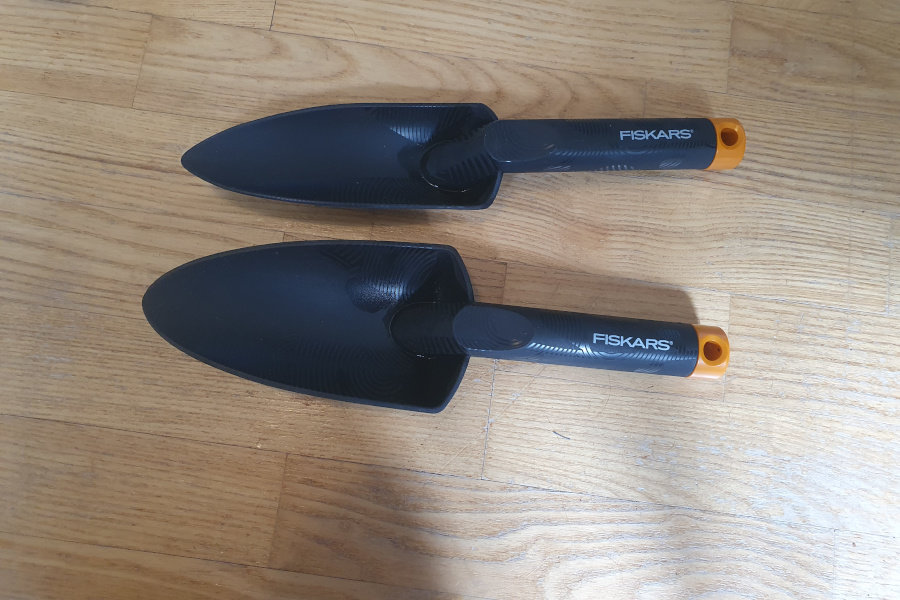This post contains affiliate links.
Once seedlings reach a certain size, it can be necessary to transplant them to give them more room to grow. Transplanting is a simple process that hardly requires any tools, but what gardening tools are actually used for transplanting seedlings?
The only gardening tool needed for transplanting seedlings is a hand trowel. If you are not planting your seedlings directly in the ground, you also need a pot or a container and some soil. Use the hand trowel to dig a hole for your seedling in the ground or soil and to fill in the hole after placing your seedling in it.
Keep reading to learn about a few more things I like to use when I transplant seedlings. I also come with a recommendation for a specific hand trowel that I have been using for a while myself and a brief explanation of why I like it so much.

What Gardening Tools are Used for Transplanting Seedlings?
Transplanting essentially means moving your plants to another place. It is usually done to provide plants with more room to grow and more soil for their root systems to expand.
Seedlings are often started in small pots or containers since it is a very space-efficient way of starting plants. When the seedlings start growing, however, the small pots or containers will quickly begin to inhibit their growth. When this happens, it is time to transplant the seedlings to a bigger pot or container or even directly into the ground.
When transplanting seedlings, the only necessary tool is a hand trowel. It can be used to dig a hole for the seedling and to cover the hole after the seedling has been placed carefully in it. Other optional things are soil, a pot, water, and gardening gloves.
If you don’t already have a good hand trowel, you should absolutely get one since they make so many tasks much easier. You can get some very nice ones. but if you just want something inexpensive that does the job well, I recommend the large one I have in the photo above. You can find it on Amazon on this link.
Hand trowels are used for digging holes and transplanting seedlings but can also be used for removing unwanted weeds and mixing soil. They are small and easy to use, but if you need to dig large holes, a spade or shovel is better suited.
Other than a hand trowel, there are a couple of other things I like to use when I transplant seedlings.
These things a good to have when transplanting seedlings:
- Hand trowel (I use this one)
- Gardening gloves (If you don’t work with thorny plants, I recommend and use some that are very similar to these from Amazon).
- Soil
- Pot (As you can see all over my website, I always use and recommend terra cotta pots such as these from Amazon because of the way the material helps keep the soil healthy).
- Water
I like to use gardening gloves to protect my hands when I transplant seedlings. There are many types of gardening gloves, but I like to use some that are a little bit tight (of course, without getting uncomfortable) since they just inhibit finger movement much less and are just easier to use while still protecting your hands.
Unless you are putting your seedling directly in the ground in your garden, you need a pot or a container and some potting soil. I like to use some very standard terracotta pots since they just seem to be some of the best pots you can get for growing plants for food, and they are also pretty cheap. You can usually find them at most garden centers or plant nurseries.
After you have transplanted your seedling, you should water it. If you grow in a pot, it can be a good idea to add water to the plate instead of the top of the soil since watering from the bottom can promote root growth since the roots need to grow and seek out the water to a higher degree than if you water from the top.
Which Garden Hand Trowel Should You Get?

Hand trowels are among the most simple gardening tools, but they make some of the most basic tasks much easier and faster. Sure, you can dig holes and mix and move soil around with your hands, and I often end up doing that if I don’t have my trowel right next to me, but a trowel just makes it so much easier and faster.
You should probably not go after the cheapest hand trowel you can find since it could potentially break if the soil you handle is too hard or contains stones or similar. That being said, there is absolutely no need to overspend. You can get some excellent hand trowels very cheaply.
I use the hand trowels from the photo above. I like to have two hand trowels of different sizes since one sometimes fits better than the other for whatever I am doing. They are very simple, weren’t expensive at all, and get the job done. I highly recommend them. If you only want one, I recommend picking the wider one.
Like any other gardening tool, the selection of hand trowels is almost endless, and it can sometimes be overwhelming to try to find the best one. The truth is that as long as you buy one that is of decent quality, you will be just fine. Just find one you like.

